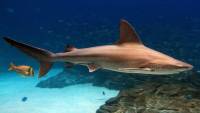 The sandbar shark, Carcharhinus plumbeus, is a species of requiem shark, family Carcharhinidae, native to the Atlantic Ocean and the Indo-Pacific. It is distinguishable by its very high first dorsal fin and inter-dorsal ridge. The sandbar shark is also called the thickskin shark or brown shark. It is one of the biggest coastal sharks in the world, and is closely related to the dusky shark, the bignose shark, and the bull shark. Its dorsal fin is triangular and very high and it has very long pectoral fins. Sandbar sharks usually have heavy-set bodies and rounded snouts that are shorter than the average shark's snout. Their upper teeth have broadly uneven cusps with sharp edges. Its second dorsal fin and anal fin are close to the same height. Females reach sexual maturity around the age of 13 with an average fork-length (tip of the nose to fork in the tail) of 154.9 cm, while males tend to reach maturity around age 12 with an average fork-length of 151.6 cm. Females can grow to 2–2.5 m (6.6-8.2 ft), males up to 1.8 m (5.9 ft). Its body color can vary from a bluish to a brownish grey to a bronze, with a white or pale underside. Sandbar sharks swim alone or gather in sex-segregated schools that vary in size.
The sandbar shark, true to its nickname, is commonly found over muddy or sandy bottoms in shallow coastal waters such as bays, estuaries, harbors, or the mouths of rivers, but it also swims in deeper waters (200 m or more) as well as intertidal zones. Sandbar sharks are found in tropical to temperate waters worldwide; in the western Atlantic they range from Massachusetts to Brazil. Juveniles are common to abundant in the lower Chesapeake Bay, and nursery grounds are found from Delaware Bay to South Carolina. Other nursery grounds include Boncuk Bay in Marmaris, Muğla/Turkey and the Florida Keys.
The sandbar shark, Carcharhinus plumbeus, is a species of requiem shark, family Carcharhinidae, native to the Atlantic Ocean and the Indo-Pacific. It is distinguishable by its very high first dorsal fin and inter-dorsal ridge. The sandbar shark is also called the thickskin shark or brown shark. It is one of the biggest coastal sharks in the world, and is closely related to the dusky shark, the bignose shark, and the bull shark. Its dorsal fin is triangular and very high and it has very long pectoral fins. Sandbar sharks usually have heavy-set bodies and rounded snouts that are shorter than the average shark's snout. Their upper teeth have broadly uneven cusps with sharp edges. Its second dorsal fin and anal fin are close to the same height. Females reach sexual maturity around the age of 13 with an average fork-length (tip of the nose to fork in the tail) of 154.9 cm, while males tend to reach maturity around age 12 with an average fork-length of 151.6 cm. Females can grow to 2–2.5 m (6.6-8.2 ft), males up to 1.8 m (5.9 ft). Its body color can vary from a bluish to a brownish grey to a bronze, with a white or pale underside. Sandbar sharks swim alone or gather in sex-segregated schools that vary in size.
The sandbar shark, true to its nickname, is commonly found over muddy or sandy bottoms in shallow coastal waters such as bays, estuaries, harbors, or the mouths of rivers, but it also swims in deeper waters (200 m or more) as well as intertidal zones. Sandbar sharks are found in tropical to temperate waters worldwide; in the western Atlantic they range from Massachusetts to Brazil. Juveniles are common to abundant in the lower Chesapeake Bay, and nursery grounds are found from Delaware Bay to South Carolina. Other nursery grounds include Boncuk Bay in Marmaris, Muğla/Turkey and the Florida Keys.
